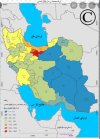after 15 year, well they did nothing , only with one year money of importing black textile from east Asia , we could have become an exporter. why didn't we did that , not because it was fattening pocket of some people in power ?
No idea, would need to research the topic. Also no idea what the current import tariff on the black fabric used in chadors is.
But as it stands, blame cannot be pinned onto religious institutions. Nor is the fact that black chadors were welcomed after the Revolution a cause onto itself for the loss of income incurred by the domestic textile industry in this regard. Negligence and/or corruption may be but then again that wouldn't be unique to black chadors.
what i can say to you the chador was not the colorful one , the clothes behind it was colorful and 70% of Iran population didn't wear it as they were not in big cities but in urban area and they wore what i posted before . it was colorful and whatever you do you cannot deny it.
You didn't offer evidence to that effect. I showed valid sources documenting the use of black chadors during various periods of time as far back as thousand years ago and straight across Iran's vast territory (north, center, east).
And some of the historic documents you yourself shared, like the accounts by French travelers during the Safavid period contradict your statement, since they show there was no color at all in the standard female dress of that time (plain white equaling absence of color, by definition)
and again no in zandyeh the black chador was not widespread .
There's no evidence for this claim. And even less so for the hypothesis that those bright multicolored tribal garments were as dominant as that.
career historian not even put his foot inside Iran ,compared to an scholar from the exact same region . also if I'm to believe every nonsense from career historians do you agree that you also accept anything they say about other matters
How do we know he never visited the region? Besides this is history not archeology or sociology. Depending on the topic and on the location of archives as well as on the availability of primary source reproductions, a historian may well forego in situ field research and still produce competent work.
by the way did the career historian brought any proof for his claim
I doubt that authors who contribute to the Encyclopaedia Iranica will reference just any random source, including ones which don't conform to the absolute minimal threshold in terms of following the scientific method. And I'm saying this despite the problems I have with this publication, in light of its editor in chief Ehsan Yarshater's political background.
were deylamite , but didn't have that nonsense law that women are not allowed out in days .
the area was an agricultural area that women worked side by side by their men , it was impossible to restrict them to their house during the day.
Sure it was possible, and there's no reason to assume such a law couldn't have been in place. Female workforce in agriculture wasn't an omnipresent occurrence during that period of time.
that style seems to be her way to annoy his brother by copying him
Some contemporary feminist narratives tell a different story, claiming that this was part of cultural perceptions of beauty in 19th century Iran, which they seek to misrepresent as tainted by transsexualism. In fact a book was published in English based on that kind of thesis. But we all know how useless feminist and homosexualist discourse is now, don't we.











